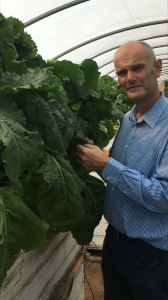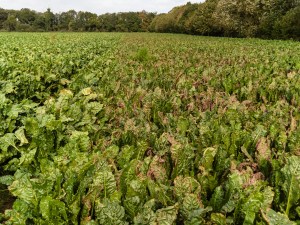Written by CPM Magazine from CPM Magazine
Download PDF
Effectively managing the canopy characteristics of sugar beet is the foundation of a healthy and profitable crop. In a world where the list of pest and disease threats keeps growing, CPM explores the importance of maximising the green leaf power.
By Janine Adamson
Cercospora, powdery mildew, rust and ramularia, not to forget drought, frost, virus yellows and now the potential occurrence of beet moth. The list of threats goes on, yet this year, the sugar beet hectarage is up at around 96,500ha.

For this season’s sugar beet, Philip Simons says plant populations are good and if fungicide timings are kept close, growers should be in for a decent crop.
“It’s the improved beet pricing which has encouraged the increased crop area,” says Prime Agriculture agronomist, Philip Simons. “Plant populations are very good and if fungicide timings are kept close, we should be in for a decent crop. Having moisture now at least helps the beet crop, if nothing else.”
However, with weather conditions turning unseasonably cool and wet [end of July], protecting the crop’s valuable green leaf area will be essential if growers are to make the most of the increased hectarage.
BBRO’s Mark Stevens says this is because sugar beet has the potential to gain 40% of its yield from September onwards. “You can’t be complacent – keeping on top of the spray programme is essential, with a watch-out for diseases such as cercospora and rust.”
A fungicide which effectively controls both diseases is Revystar XE (mefentrifluconazole+ fluxapyroxad) – available this season following a label extension for use in sugar beet. It also has action against powdery mildew and ramularia, which Mark says makes it much welcomed.
“Greater diversity in the fungicide toolbox was required, even so, it’s important to remember the principles of the BBRO’s eight-point plan for autumn disease management. A key part of this is application timing – wait for signs of disease to show, but equally, don’t hang about either,” he says. “Have no more than a 28-day gap between sprays to prevent potential re-infection.”
According to BASF’s Iain Ford, Revystar XE gives persistent disease control. “Application should be at the start of a foliar disease attack and a maximum of two applications can be made, with a minimum 14-day interval between treatments.
“As shown in BBRO trials, strong greening effects can be seen even where disease levels are relatively low. This maintenance of green leaf area allows plants to photosynthesise for longer, put sugar into their roots and improve yield quality,” he says.
In terms of rate, Iain says this depends on the disease present – 1.0 l/ha is recommended for cercospora whereas 0.8 l/ha is more suitable for rust, powdery mildew and ramularia. “Some stock may be out there without sugar beet on the label but it can still be used,” he stresses.

Maintaining green leaf area allows plants to photosynthesise for longer, put sugar into their roots, and improve yield quality, says Iain Ford.
Philip explains fungicides have become even more intrinsic to the success of sugar beet growing, given modern campaigns are much longer. “It’s all about canopy preservation. Not only does this mitigate the impact of disease, but it also protects the crop from potential frost damage.
“That said, if growers are lifting beet early towards the end of September, it’s important to be mindful of fungicide application timings and harvest intervals,” he says.
Despite earlier conditions not lending themselves to infection, there’s been much talk about cercospora – a disease which can cause up to 50% yield loss. “Cercospora likes warm, humid conditions above 25oC. So far this year, we’ve had either moisture or heat, but not the two together,” says Mark.
“The problem is, it rapidly degrades the crop’s canopy and is also high risk for evolving and developing resistance. BBRO is monitoring the disease in the UK to understand the current situation and to help inform future programme management.”
Mark’s team is also working with breeders with a view to developing new traits for genetic resistance. Importantly, cercospora is now part of BBRO Recommended List ratings.
Although this is a positive move, due to not having a bad year for the disease recently, Philip says the data hasn’t been fully tested. “The cercospora scores are bracketed which means the data is limited, for example, lower scoring varieties are Stewart ([5.5]) and Annatina KWS ([5.9]). We perhaps won’t truly know until we have a bad year for the disease.”
He says the biggest issue is timing and the fact that follow-up treatments can sometimes take a backseat. “The problem is, second fungicide application can often coincide with the cereal crop harvest and as with most crops, application interval is important. Everyone is distracted and this could give cercospora and rust the chance to take hold,” he says.

Mark Stevens says cercospora likes warm, humid conditions above 250 C but so far this year, we’ve had either moisture or heat but not the two together.
Syngenta’s Andy Cunningham says the two actives found in Priori Gold (azoxystrobin+ difenoconazole) also offer valuable action against sugar beet diseases, especially rust, which conditions currently favour.
“In a similar high rust pressure scenario last year, trials in Lincolnshire showed a two-spray Priori Gold programme in August reduced the infected leaf area from the more than 85% found in untreated plots, to less than 20%,” he says.
Andy advises that two applications can be made per crop at a rate of 1.0 l/ha with the latest application timing being when roots have reached harvestable size (GS49), and no less than 35 days before harvest.
However, it’s the greening effect of strobilurins which adds value, says Andy. “The azoxystrobin found in Priori Gold works by inhibiting the electron transfer in the mitochondria of the fungus, causing it to run out of energy and die. But the well-documented ‘greening’ benefit is arguably just as important.”
He explains that improving the green leaf area enhances the rate of photosynthesis in the treated crop, which not only improves yield and sugar content of the root, but also create a more resilient plant through periods of stress such as freezing temperatures.
“Strobilurins extend the life of crop leaves by reducing the plant senescence process and improving the retention of chlorophyll content, which is essential for the photoassimilates critical for yield.
“This is due to strobilurins decreasing levels of the amino acid, acetyl carboxylic acid (ACC), which acts as the direct precursor of ethylene, which then leads to chlorophyll loss,” explains Andy.
For those heading into T2 fungicide timings and beyond, Philip reminds that as of last year, Caligula (fluopyram+ prothioconazole) can be used from 1 September onwards for late onset cercospora control. “Most growers seem to have been able to apply a first round of fungicide, which is reassuring given recent downpours.
“To follow up, Caligula is authorised for a single spray at a maximum rate of 1.2 l/ha, although the recommended rate is 1.0 l/ha. It’s a particularly good option for those lifting beyond mid-October who’ll be considering going through a third time,” he says. “It’s our second year with Caligula and it’s been a welcome replacement following the loss of Escolta.”

Cercospora rapidly degrades the crop’s canopy and is high risk for evolving and developing resistance.
Philip warns of the cumulative cost of a robust sugar beet fungicide programme this season. “Necessary disease control is becoming rather expensive due to the requirement for best-in-class chemistry – currently around £80/ha for a good fungicide programme. This jumps to more than £100/ha for those crops requiring three sprays,” he comments.
“But recent fungicide introductions are very welcome for the beet crop, when we’ve lost so many actives over the years. Hopefully we can look forward to some positive yield responses with the addition of the newer chemistry.”
He also stresses the role of trace elements throughout the sugar beet crop’s lifecycle, which can be applied as multi-nutrient mixes, along with fungicides, to prolong greenness. “Fungicides and trace elements are major contributors to the maintenance of a clean, healthy crop canopy. Manganese and magnesium are particularly important in helping to retain chlorophyll and so green leaves.”
According to Philip, different beet varieties can have very varied canopy characteristics. “Not only is it about greenness, but it’s also how the varieties stand and present themselves – some have longer petioles [the stalk that attaches the leaf blade to the stem] whereas others have larger leaves. This could be important when selecting varieties for say different locations, weed pressures or lifting periods.
“Although these traits might not be high on the agenda for growers when they’re selecting varieties, we may see the concept being explored more based purely on how much the above ground canopy impacts the below ground crop,” he concludes.
This article was taken from the latest issue of CPM. Read the article in full here.
For more articles like this, subscribe here.
Sign up for Crop Production Magazine’s FREE e-newsletter here.
The post Sugar beet: Capitalising on the canopy appeared first on cpm magazine.
Continue reading on CPM website...
If you are enjoying what you read then why not considering subscribing here: http://www.cpm-magazine.co.uk/subscribe/
Download PDF
Effectively managing the canopy characteristics of sugar beet is the foundation of a healthy and profitable crop. In a world where the list of pest and disease threats keeps growing, CPM explores the importance of maximising the green leaf power.
“Recent fungicide introductions are very welcome for the beet crop when we’ve lost so many actives over the years.”
By Janine Adamson
Cercospora, powdery mildew, rust and ramularia, not to forget drought, frost, virus yellows and now the potential occurrence of beet moth. The list of threats goes on, yet this year, the sugar beet hectarage is up at around 96,500ha.

For this season’s sugar beet, Philip Simons says plant populations are good and if fungicide timings are kept close, growers should be in for a decent crop.
“It’s the improved beet pricing which has encouraged the increased crop area,” says Prime Agriculture agronomist, Philip Simons. “Plant populations are very good and if fungicide timings are kept close, we should be in for a decent crop. Having moisture now at least helps the beet crop, if nothing else.”
However, with weather conditions turning unseasonably cool and wet [end of July], protecting the crop’s valuable green leaf area will be essential if growers are to make the most of the increased hectarage.
BBRO’s Mark Stevens says this is because sugar beet has the potential to gain 40% of its yield from September onwards. “You can’t be complacent – keeping on top of the spray programme is essential, with a watch-out for diseases such as cercospora and rust.”
A fungicide which effectively controls both diseases is Revystar XE (mefentrifluconazole+ fluxapyroxad) – available this season following a label extension for use in sugar beet. It also has action against powdery mildew and ramularia, which Mark says makes it much welcomed.
“Greater diversity in the fungicide toolbox was required, even so, it’s important to remember the principles of the BBRO’s eight-point plan for autumn disease management. A key part of this is application timing – wait for signs of disease to show, but equally, don’t hang about either,” he says. “Have no more than a 28-day gap between sprays to prevent potential re-infection.”
According to BASF’s Iain Ford, Revystar XE gives persistent disease control. “Application should be at the start of a foliar disease attack and a maximum of two applications can be made, with a minimum 14-day interval between treatments.
“As shown in BBRO trials, strong greening effects can be seen even where disease levels are relatively low. This maintenance of green leaf area allows plants to photosynthesise for longer, put sugar into their roots and improve yield quality,” he says.
In terms of rate, Iain says this depends on the disease present – 1.0 l/ha is recommended for cercospora whereas 0.8 l/ha is more suitable for rust, powdery mildew and ramularia. “Some stock may be out there without sugar beet on the label but it can still be used,” he stresses.

Maintaining green leaf area allows plants to photosynthesise for longer, put sugar into their roots, and improve yield quality, says Iain Ford.
Philip explains fungicides have become even more intrinsic to the success of sugar beet growing, given modern campaigns are much longer. “It’s all about canopy preservation. Not only does this mitigate the impact of disease, but it also protects the crop from potential frost damage.
“That said, if growers are lifting beet early towards the end of September, it’s important to be mindful of fungicide application timings and harvest intervals,” he says.
Despite earlier conditions not lending themselves to infection, there’s been much talk about cercospora – a disease which can cause up to 50% yield loss. “Cercospora likes warm, humid conditions above 25oC. So far this year, we’ve had either moisture or heat, but not the two together,” says Mark.
“The problem is, it rapidly degrades the crop’s canopy and is also high risk for evolving and developing resistance. BBRO is monitoring the disease in the UK to understand the current situation and to help inform future programme management.”
Mark’s team is also working with breeders with a view to developing new traits for genetic resistance. Importantly, cercospora is now part of BBRO Recommended List ratings.
Although this is a positive move, due to not having a bad year for the disease recently, Philip says the data hasn’t been fully tested. “The cercospora scores are bracketed which means the data is limited, for example, lower scoring varieties are Stewart ([5.5]) and Annatina KWS ([5.9]). We perhaps won’t truly know until we have a bad year for the disease.”
He says the biggest issue is timing and the fact that follow-up treatments can sometimes take a backseat. “The problem is, second fungicide application can often coincide with the cereal crop harvest and as with most crops, application interval is important. Everyone is distracted and this could give cercospora and rust the chance to take hold,” he says.

Mark Stevens says cercospora likes warm, humid conditions above 250 C but so far this year, we’ve had either moisture or heat but not the two together.
Syngenta’s Andy Cunningham says the two actives found in Priori Gold (azoxystrobin+ difenoconazole) also offer valuable action against sugar beet diseases, especially rust, which conditions currently favour.
“In a similar high rust pressure scenario last year, trials in Lincolnshire showed a two-spray Priori Gold programme in August reduced the infected leaf area from the more than 85% found in untreated plots, to less than 20%,” he says.
Andy advises that two applications can be made per crop at a rate of 1.0 l/ha with the latest application timing being when roots have reached harvestable size (GS49), and no less than 35 days before harvest.
However, it’s the greening effect of strobilurins which adds value, says Andy. “The azoxystrobin found in Priori Gold works by inhibiting the electron transfer in the mitochondria of the fungus, causing it to run out of energy and die. But the well-documented ‘greening’ benefit is arguably just as important.”
He explains that improving the green leaf area enhances the rate of photosynthesis in the treated crop, which not only improves yield and sugar content of the root, but also create a more resilient plant through periods of stress such as freezing temperatures.
“Strobilurins extend the life of crop leaves by reducing the plant senescence process and improving the retention of chlorophyll content, which is essential for the photoassimilates critical for yield.
“This is due to strobilurins decreasing levels of the amino acid, acetyl carboxylic acid (ACC), which acts as the direct precursor of ethylene, which then leads to chlorophyll loss,” explains Andy.
For those heading into T2 fungicide timings and beyond, Philip reminds that as of last year, Caligula (fluopyram+ prothioconazole) can be used from 1 September onwards for late onset cercospora control. “Most growers seem to have been able to apply a first round of fungicide, which is reassuring given recent downpours.
“To follow up, Caligula is authorised for a single spray at a maximum rate of 1.2 l/ha, although the recommended rate is 1.0 l/ha. It’s a particularly good option for those lifting beyond mid-October who’ll be considering going through a third time,” he says. “It’s our second year with Caligula and it’s been a welcome replacement following the loss of Escolta.”

Cercospora rapidly degrades the crop’s canopy and is high risk for evolving and developing resistance.
Philip warns of the cumulative cost of a robust sugar beet fungicide programme this season. “Necessary disease control is becoming rather expensive due to the requirement for best-in-class chemistry – currently around £80/ha for a good fungicide programme. This jumps to more than £100/ha for those crops requiring three sprays,” he comments.
“But recent fungicide introductions are very welcome for the beet crop, when we’ve lost so many actives over the years. Hopefully we can look forward to some positive yield responses with the addition of the newer chemistry.”
He also stresses the role of trace elements throughout the sugar beet crop’s lifecycle, which can be applied as multi-nutrient mixes, along with fungicides, to prolong greenness. “Fungicides and trace elements are major contributors to the maintenance of a clean, healthy crop canopy. Manganese and magnesium are particularly important in helping to retain chlorophyll and so green leaves.”
According to Philip, different beet varieties can have very varied canopy characteristics. “Not only is it about greenness, but it’s also how the varieties stand and present themselves – some have longer petioles [the stalk that attaches the leaf blade to the stem] whereas others have larger leaves. This could be important when selecting varieties for say different locations, weed pressures or lifting periods.
“Although these traits might not be high on the agenda for growers when they’re selecting varieties, we may see the concept being explored more based purely on how much the above ground canopy impacts the below ground crop,” he concludes.
This article was taken from the latest issue of CPM. Read the article in full here.
For more articles like this, subscribe here.
Sign up for Crop Production Magazine’s FREE e-newsletter here.
The post Sugar beet: Capitalising on the canopy appeared first on cpm magazine.
Continue reading on CPM website...
If you are enjoying what you read then why not considering subscribing here: http://www.cpm-magazine.co.uk/subscribe/





